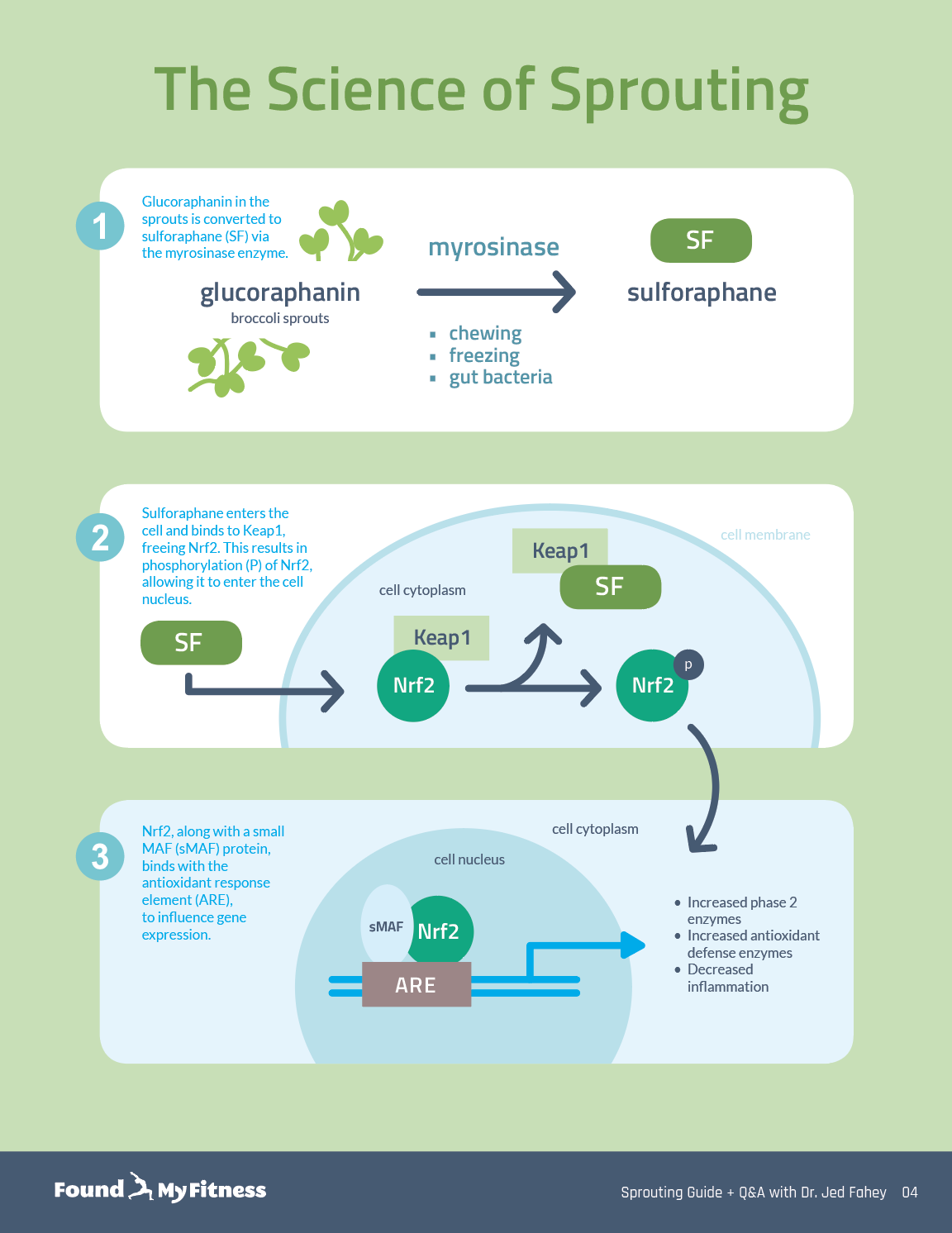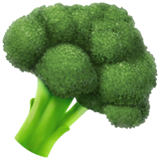Seeds of cruciferous plants contain the highest levels of isothiocyanate precursors | Jed Fahey
Enter your email to get our 15-page guide to sprouting broccoli and learn about the science of chemoprotective compount sulforaphane.
Broccoli sprouts are concentrated sources of sulforaphane, a type of isothiocyanate. Damaging broccoli sprouts – when chewing, chopping, or freezing – triggers an enzymatic reaction in the tiny plants that produces sulforaphane.

Get the full length version of this episode as a podcast.
This episode will make a great companion for a long drive.
That fiery sensation that occurs when you eat certain cruciferous plants such as horseradish or mustard is the result of a chemical reaction between two compounds (a glucosinolate and myrosinase) present in the plant. Dubbed the "mustard oil bomb," this reaction is a defense system that protects plants from insect attack – and human consumption. The end product of the reaction is an isothiocyanate compound that activates cytoprotective mechanisms in humans in a hormetic-type response. The seeds of cruciferous vegetables are particularly good sources of isothiocyanates, but care must be taken to preserve the myrosinase, which is heat sensitive. In this clip, Dr. Jed Fahey describes the chemical reaction that produces isothiocyanates and cautions against preparation techniques that might inhibit their production.
Jed: You know, when I give lectures to students, I frequently make, point out to them how they're doing this glucoraphanin into sulforaphane conversion, so I will do it for this webinar.
When you chew on a red radish, you're familiar with the fact that the first sensation is cool and crunchy and then within 20, 30 seconds, you develop heat, you start tearing, your nose starts running, has a lachrymating effect. So what you are doing is you're acting like that insect that I told you lands on a leaf of a broccoli plant. You're breaking the plant cells by crunching on the radish, you're releasing a compound that's very, very similar to glucoraphanin. It's actually called glucoraphanin in radishes. It happens to be more of a lachrymator. It's got a more mucus-inducing effect in people. And you're letting myrosinase in those radish tissues act on glucoraphanin and form sulforaphane and some other related isothiocyanates. That's the broad name for that category. So it happens that fast when you chew on fresh vegetables that contain this system.
Rhonda: Does sulforaphene also activate Nrf2?
Jed: It does, but to a lesser degree than sulforaphane.
Rhonda: So many of these isothiocyanates also activate Nrf2, but not to the same degree as sulforaphane?
Jed: They do. And just in case you're about to ask me, you find this system, it's been dubbed the mustard oil bomb by some, 20 or 30 years ago. You find this system almost exclusively in cruciferous vegetables, or brassica vegetables or cole crops, they're sometimes called, depending upon where you come from, where you hail from. In Eastern Europe, they typically call them cole crops. So this happens to be a very large family of, I don't know, 500 or 600 genera, many, many thousands of species.
Rhonda: Yeah, I know, like, maybe 10 of them.
Jed: Well, we know maybe 20, but, I mean, there are very many of them. And they grow worldwide although the brassica or the cold crops that we're familiar with in the United States are all temperate climate crops. They're common to areas where there's a cold winter or a freeze in the winter. There are some interesting relatives we can talk about later or now if you like which are tropical. Moringa is the one which has gotten most attention recently and we've been interested in for about 20 years. It's a relative of broccoli, but it's a tropical plant. It's actually a tree. And it, too, has this system of glucosinolate, myrosinase, and isothiocyanate. The former being the storage form in the plant, the latter being the biologically active form.
Rhonda: Right, okay. Yeah, maybe we can get to that little bit later, but talk a little bit more about the sulforaphane in the broccoli sprouts. I wanted to ask you something because you mentioned, it really piqued my attention, as you said that broccoli seeds actually had higher amount of glucoraphanin than the sprout. If I were to say take those broccolis, because I sprout, If I were to take those broccoli seeds, add a little water and blend them in a blender, would that activate myrosinase within the seed, the crushing of the seed?
Jed: You bet.
Rhonda: So I could actually get a higher, more potent amount of sulforaphane theoretically if I were to just take the seeds and because... Man, that would be easier than sprouting in a way.
Jed: Yes. That's true. So, interestingly when we discovered that, and this was published in 1997, so it's ancient history. It's probably before you were born, right? So when we discovered that broccoli sprouts in seeds were such a potent source of sulforaphane or its precursor, we weren't aware that anybody had eaten broccoli seeds. People eat all sorts of seeds, poppy seeds and rapeseed or canola seed, in fact, are used to express oil and they're a close relative. But no one had eaten broccoli seeds. And when we tried them, they're quite bitter. But interestingly, if you bake them just gently, don't scorch them, if you bake them, they get their very nutty taste and they're sort of pleasant tasting. The problem is if you bake them, you kill the enzyme, you kill myrosinase. Because it's a...
Rhonda: Right. So that's something important, retention.
Jed: Yeah. So there actually have been some epidemiologic studies, and I'm getting off topic a bit, but some epidemiologic studies suggesting that people who eat certain amounts of cruciferous vegetables have reduced risks of various cancers. Breast cancer and lung cancer are high on the list of cancers that have been studied. Excuse me. And it turns out that if you eat raw cruciferous vegetables, you're a bit better protected, again, based on the epidemiology. This has not been the subject of interventions of randomized clinical trials, for example. But it looks like the protective effect is greater if you eat raw vegetables. But now, a lot of people don't like to eat raw cauliflower or broccoli or...well, radishes, they do. So at any rate, you asked about the content in broccoli seeds and indeed, they have much more glucoraphanin and they have plenty of active myrosinase. But I have a feeling, I've never made a smoothie from raw broccoli seeds. I have a feeling it would be pretty bitter.
Rhonda: I'll let you know, because I'm going to try it.
Jed: I thought you might.
Any of a group of complex proteins or conjugated proteins that are produced by living cells and act as catalyst in specific biochemical reactions.
A glucosinolate (see definition) found in certain cruciferous vegetables, including broccoli, Brussels sprouts, and mustard. Glucoraphanin is hydrolyzed by the enzyme myrosinase to produce sulforaphane, an isothiocyanate compound that has many beneficial health effects in humans.
Plant secondary metabolites found primarily in cruciferous vegetables. Glucosinolates give rise to a variety of compounds that have been identified as potent chemoprotective agents in humans against the pathogenesis of many chronic diseases such as cancer, cardiovascular disease, and neurodegenerative disease, among others. These products are responsible for the pungent aroma, sharp flavor, and the “heat” commonly associated with some cruciferous vegetables such as wasabi and horseradish.
Byproduct of a reaction between two compounds (glucosinolates and myrosinase) that are found in cruciferous vegetables. Isothiocyanates inhibit phase I biotransformation enzymes, a class of enzymes that transform procarcinogens into their active carcinogenic state. Isothiocyanates activate phase II detoxification enzymes, a class of enzymes that play a protective role against DNA damage caused by reactive oxygen species and carcinogens. Examples of phase II enzymes include UDP-glucuronosyltransferases, sulfotransferases, N-acetyltransferases, glutathione S-transferases, and methyltransferases.
Also known as the drumstick tree or the horseradish tree. Moringa oleifera is rich in protein, micronutrients, and glucosinolates and is associated with a wide range of health benefits. It is a fast-growing, drought-resistant tree, native to the southern foothills of the Himalayas in northwestern India.
A family of enzymes whose sole known substrates are glucosinolates. Myrosinase is located in specialized cells within the leaves, stems, and flowers of cruciferous plants. When the plant is damaged by insects or eaten by humans, the myrosinase is released and subsequently hydrolyzes nearby glucosinolate compounds to form isothiocyanates (see definition), which demonstrate many beneficial health effects in humans. Microbes in the human gut also produce myrosinase and can convert non-hydrolyzed glucosinolates to isothiocyanates.
A protein typically present in the cytoplasm of mammalian cells. Nrf2 can relocate to the nucleus where it regulates the expression of hundreds of antioxidant and stress response proteins that protect against oxidative damage triggered by injury and inflammation. One of the most well-known naturally-occurring inducers of Nrf2 is sulforaphane, a compound derived from cruciferous vegetables such as broccoli.
An isothiocyanate compound derived from cruciferous vegetables such as broccoli, cauliflower, and mustard. Sulforaphane is produced when the plant is damaged when attacked by insects or eaten by humans. It activates cytoprotective mechanisms within cells in a hormetic-type response. Sulforaphane has demonstrated beneficial effects against several chronic health conditions, including autism, cancer, cardiovascular disease, diabetes, and others.
Hear new content from Rhonda on The Aliquot, our member's only podcast

Listen in on our regularly curated interview segments called "Aliquots" released every week on our premium podcast The Aliquot. Aliquots come in two flavors: features and mashups.
- Hours of deep dive on topics like fasting, sauna, child development surfaced from our enormous collection of members-only Q&A episodes.
- Important conversational highlights from our interviews with extra commentary and value. Short but salient.
Sulforaphane News
- Broccoli seed extract with a sulforaphane precursor reduced common cold symptom days in healthy adults.
- Sulforaphane-rich broccoli sprout extract modestly lowers fasting blood sugar in some people with prediabetes, perhaps due to variations in gut microbiota and individual metabolic traits.
- Sulforaphane, derived from broccoli, activates Nrf2, mitigating age-related skin changes and boosting the antioxidant defense system in mice.
- Sulforaphane from broccoli sprouts shows promise in preventing Alzheimer's disease – boosting memory and enhancing mitochondrial function in mice.
- Breathwork enhances endogenous antioxidant enzyme activity to counter oxidative stress.






